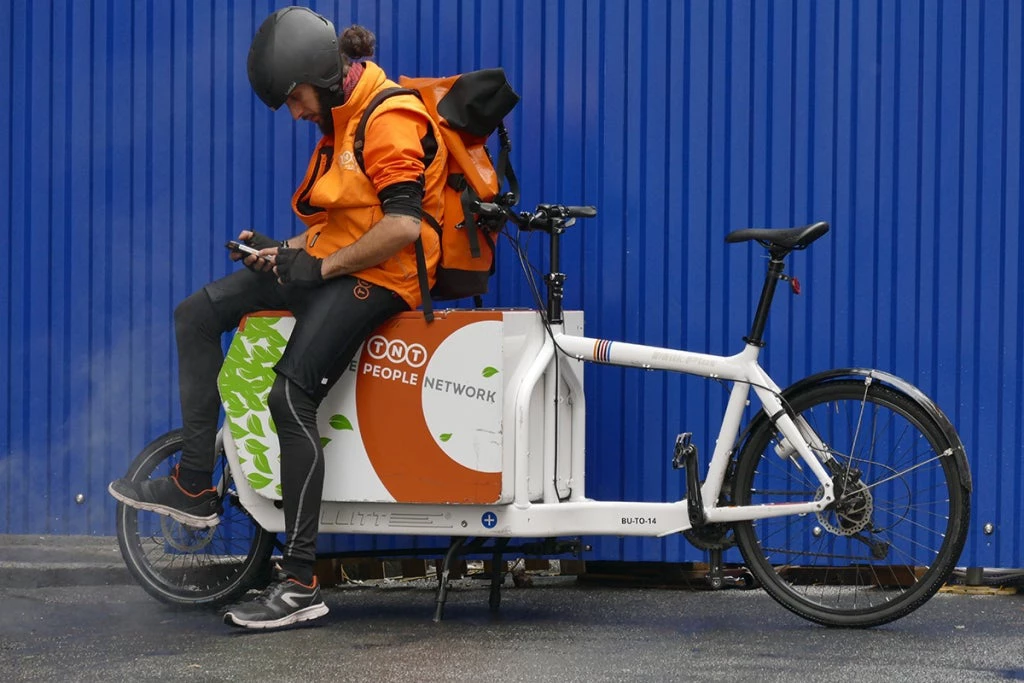
The cargo bicycle, also known as the freight or utility bike, is enjoying a renaissance and recognition as a cleaner, safer, and more efficient mode of urban freight delivery and passenger transport. As a human-powered and fuel-free vehicle, this form of active transport could bring even more benefits to our cities than other disruptive technologies. Let’s take a closer look at this reemerging technology and its potential for urban transport.
The new economy of urban deliveries
Cargo bikes are proving to be versatile vehicles of change for urban business interests thanks to their economic viability. They also reduce the need for polluting and noisy delivery trucks that contribute to urban gridlock. They make the streets cleaner and safer for pedestrians and commuting cyclists.
Research commissioned by the European Union concludes that 25% of all goods and 50% of all light deliveries in urban settings could be serviced by cargo bikes. Around the world, customers of online retailers are increasingly purchasing everything from groceries to furniture. The expectation of immediacy, especially in urban centers, has led to massive traffic increases on city streets. Meanwhile, 87% of Millennials prefer to conduct business with socially and environmentally conscientious companies. In that context, informing your customers that their package has arrived using a sustainable and environmentally friendly means of transport could become a significant commercial advantage.
Benny Engelbrecht, the Danish Minister for Transport, declared in November 2019 at the inauguration of the DHL Copenhagen City Hub: “The bicycle can’t change the world, but it is damn close.” DHL has introduced cargo bikes in their services as one of the best possible modes of more sustainable transport for urban deliveries. Cities are also partnering with private delivery companies to promote cargo bikes as an alternative to delivery trucks. New York City recently announced a new program that is allowing pedal-assisted cargo bikes operated by Amazon, UPS, and DHL to park in existing commercial loading areas typically reserved for trucks and vans. UPS has been operating cargo bikes in several European cities after they were successfully tested in Hamburg, Germany in 2012.
Cargo bikes are catching on outside of Europe, too. In Rio de Janeiro, Brazil, especially around the famous neighborhood of Copacabana, there are over 11,000 cargo bike deliveries made each day. According to the Brazilian NGO Transporte Ativo, "cargo bicycles are the best option for transporting goods over short distances and can easily be integrated into the city’s busy streets. Its use lightens the burden of motorized transport, such as congestion, parking issues, air pollution, and its impacts on climate change."
In Kigali, Rwanda, cargo bikes carry people and heavy loads of goods. Beyond their role in the transport of goods, they have also provided employment for thousands of young men as bicycle taxi drivers. In Lagos, Nigeria, cargo bikes are being utilized for garbage and waste collection.
The bright electric future ahead, led by bikes
According to Germany's Two-wheel Industry Association (ZIV), in the last year, electrically assisted cargo bikes have outsold electric cars in Germany with 39,000 sold versus 32,000 electric cars—an impressive when you consider that electric cars have benefited from substantial government subsidies, while e-bikes received only a small handout. Globally, Deloitte predicts that 300 million e-bikes will be out on the world's streets by 2023, representing a 50% increase over current numbers. These statistics seem to show that, despite all the attention around electric and autonomous vehicles, the future of e-mobility may actually be led by bikes. In the next five years, 40 million electric bikes will be sold worldwide, dwarfing the 12 million electric vehicles that will be hitting the roads over the same period.
Copenhagen and Amsterdam are at the forefront of cargo bike use. Across the Copenhagen metropolitan area, around 40,000 cargo bikes are being used every day. In Copenhagen proper, the city has found that 26% of with two or more children own a cargo bike. In fact, the primary use of cargo bikes in Copenhagen is to get children around. In Amsterdam, 90% of cargo bikes are sold to moms and dads in search of a convenient, sustainable way to transport their kids.
The comeback of the cargo bike, with the exponential growth of the electric assisted market, seems to have a large potential not only for urban deliveries, but also for passenger transport, especially for families. Whether we live in the Global South or North, we will most likely see the e-cargo bike coming to our neighborhood in one form or another as a sustainable, convenient, and inclusive transport option.
One thing’s for sure: a future on two wheels is a greener, healthier one. A future that we can feel excited about.



Join the Conversation